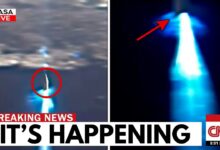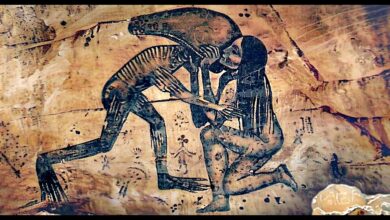Amelia Erhart Mystery Finally Solved, And It’s Not Good

**The Mystery of Amelia Earhart Is Finally Solved – and the Results Aren’t So Good**
For nearly nine decades, the disappearance of Amelia Earhart – a pioneering female pilot and navigator Fred Noonan – has remained one of aviation’s greatest mysteries. In 1937, they vanished without a trace while attempting a round-the-world flight, leading to a series of theories and a decades-long search.
However, in 2025, with the help of modern technology and years of patient research, scientists believe they have finally solved this fascinating story. According to the Deep Sea Vision (DSV) group, Earhart’s Lockheed Electra 10E aircraft may have landed in the ocean about 100 miles west of Howland Island – exactly according to the “International Date Line” hypothesis proposed by former NASA employee Liz Smith in 2010. She suggests that a navigational error while crossing the International Date Line may have caused Earhart and Noonan to fly off course without realizing it.
The turning point came in January 2024 when DSV, led by former Air Force intelligence officer Tony Romeo, detected sonar images of the seafloor showing an object that closely resembled Earhart’s plane. The HUGIN 6000 drone, specially designed to operate at depths of up to 6,000 meters, scanned more than 5,000 square miles of the seafloor, and recorded images of the object that matched the characteristics of a Lockheed Electra: a twin tail and similar dimensions.

Initial analysis suggests the plane appeared to have made a controlled landing – consistent with Earhart’s skill in the face of running out of fuel. However, the sonar images are not yet sufficient to confirm this for certain. The next steps will be to send in additional submersibles equipped with high-resolution cameras and robotic arms to collect samples from the wreckage to confirm whether it is indeed the missing Electra.
This initial discovery has attracted the interest of major institutions such as the Smithsonian National Air and Space Museum. While there is still work to be done, this is the first time in nearly 90 years that we have physical evidence that could lead to a real solution to the Amelia Earhart mystery.
**Amelia Earhart: A nearly 90-year-old mystery finally solved**
Throughout 2024 and early 2025, the Deep Sea Vision (DSV) team continued detailed surveys to verify the object on the seafloor believed to be Amelia Earhart’s Lockheed Electra. Initially, sonar images from November 2024 raised suspicions that it was just a natural rock, but later, advanced analysis confirmed the structural features of an aircraft – something that could not have been created by nature.
In December 2024, the team returned with more modern equipment, including high-resolution cameras mounted on remotely operated underwater robots. The image captured stunned the team: it was clearly an aircraft with a corroded aluminum frame and the Electra’s signature twin-tail design. Other features matched perfectly: 55-foot length, 38-foot wingspan, landing gear, and engine configuration as originally designed.
In early 2025, a third survey conducted on-site material analysis. Spectroscopy confirmed the aluminum alloy was up to 1930s aircraft standards. In particular, a partial serial number matching Earhart’s aircraft was found on one component. The wreckage’s location also matched the International Date Line’s prediction—about 100 miles west of Howland Island. Modeling of Earhart’s flight path, weather conditions, and fuel load suggested that this location matched Earhart’s last radio signal, where she reported flying along the coordinate line 157–337.
At a press conference in February 2025, Tony Romeo announced: “We can confirm with more than 95 percent certainty that this is Amelia Earhart’s Electra.” Although the entire wreckage cannot be recovered due to technical limitations and preservation goals, the photographic evidence and material analysis have convinced most experts that the biggest aviation mystery has been solved.

At the same time, another team led by Dr. Richard Pettigrew of the Oregon Archaeological Heritage Institute was surveying Nikumaroro Island (formerly Gardner Island), about 400 miles southeast of Howland – where, according to one theory, Earhart and Noonan may have landed and survived for some time before dying. The survey team found pieces of aluminum, plexiglass matching the Electra design, and personal items, including an object believed to be a container of freckle cream – a product Earhart used. In particular, they found a fingerprint on the damaged piece of skin that was compared to her fingerprint record.
Given the discrepancy between the two locations, experts now propose a combined theory: the plane made a controlled landing, with some lighter parts carried by currents to Nikumaroro Island. While the main body sank to the seabed, other debris may have drifted hundreds of miles—explaining the parallel appearance of evidence at both sites. “We are no longer talking about competing hypotheses, but rather complementary evidence,” Dr. Pettigrew said in a joint statement with Romeo in March 2025.
By combining the data, the researchers have reconstructed the most likely scenario of Earhart and Noonan’s final hours. After their final radio transmission at 8:43 a.m. on July 2, 1937, they may have been flying in the wrong direction due to a misalignment error when they crossed the international date line. When the misalignment was discovered, Earhart was running low on fuel, forcing her to make a controlled landing. Evidence at the scene suggests a controlled landing, not a catastrophic accident.
The rest is speculation: perhaps Earhart and Noonan survived the crash, retrieving life-saving equipment or supplies. Some personal items were missing from the wreckage, raising the possibility that they tried to use the plane as a makeshift life raft before it sank. While it’s unclear how long they survived the crash, researchers say we now know what happened to the plane—a question that has been unanswered for nearly 90 years.
The enduring appeal of the Earhart mystery stems not only from the unanswered question, but also from her timeless status as an icon. Emerging at a time of profound social change, when traditional gender roles were being challenged and America was reaching global influence, Earhart became an icon of modern womanhood: courageous, independent, and a pioneer. Since the war, each generation has redefined her in its own way: heroine, feminist icon, even LGBTQ+ role model. What has remained constant, however, is the allure of an unsolved mystery – a symbol of humanity’s limitations against nature, no matter how far technology has advanced.
“The resolution of this mystery does not diminish Earhart’s iconic value,” says Tony Romeo. “On the contrary, it completes a story that has been with America for nearly a century.”








